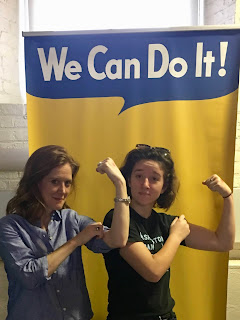What do you stand for?
Recently, while perusing social media I saw a post by a classmate from many years back. In this he stated that he appreciated customers of his business but he did not want to profit from people who harassed his female employees, either verbally on the phone or on-line. The company, Ranger Up, demonstrates here a perfect example of how great leaders take a stand against repugnant behaviors. As you look for companies that not only talk-the-talk look for evidence, like this, that they walk-the-walk. Here are a couple of tips from Colonel Candid on what to look for in a healthy workplace that supports women and proves what they stand for.
Because we all want to work for a company where women are equitably valued and respected, participation by women is encouraged. When you’re looking at working somewhere look at how employees are seen and treated. Do you sense that recruitment of excellent talent is gender-blind? If not, then the culture is askew from the starting line. The true power in collaboration of all employees comes from common goals where the valued contribution of each member is respected. Individually, ask and look to see if men and women collaborate with other groups or departments. Is equity baked into the corporate image?
Hire women, pay them, and promote them. Kim Churches, CEO of American Association of University Women says sound hiring practices hold the keys to many of the issues we see in the workplace. Diverse workforces outperform their peers and they’re also more likely to attract a mixture of talent. Be weary of what the glossy pamphlets or company webpage says about women in power positions. Estimating women in executive jobs is tricky because many companies currently measure representation by title, which can mean different things in different industries. For example, a vice president in a pharmaceutical company is a lofty title, but in finance? It’s midlevel. Instead, ask if the company your looking at has representation in buckets from three levels below CEO on up. Doing this, instead of by titles produces a better read on the company.
Ensure the company doesn’t factor a woman’s personal life into professional decisions. How refreshing it is to find an environment where pregnancy is celebrated verses discouraged. Do people talk about their children and the challenges of raising young ones or teenagers? If you see family photos around, that’s a good visual, just ensure the narrative matches the picture.
Include women in all activities and look for examples on webpages, team sports, and events the company holds. Isolating or ignoring them is absurd and trite, it exists and you’ll viscerally feel organizations who do so. Look for companies who give men and women equal opportunities to succeed. That also means you must be a team player by showing up and doing your share once you find that right fit. Ask if there are women-centric activities or events available. If none are available, and you enjoy this company, consider starting a monthly networking meeting, an internal mentoring program, or an external one at a nearby college or high school.
Communicate with Human Resources to make sure that there are corporate policies in place that prohibit discrimination and harassment. Ask how they are enforced. If policies do not exist, and you like where you work, offer to participate on a committee to create them because the day will come where someone will wish, “shoulda, coulda, woulda”.
Look for people who micro-sponsor women, advocating for women is demonstrable in so many ways. Calling people out for “mansplaining” or attempting to pull off female colleagues ideas as their own is a huge win for a healthy work environment. By demonstrations that harassment is not tolerated, not just by vague statements about zero tolerance, but by doing something, you’re creating a place women want to work. For men who speak up when witnessing alarming behavior, your impact creates a ripple effect in the company and will reverberate amongst circles of women who will want to work in your company.
When you find the place that puts principles over profit, you’ll feel that goodness and light. Trust me, profits aren’t bad but they’re so much better when you can value where you work. Look for a place where you’ll be an asset with advocates. Run away from those places where you immediately sense that you’re a number, tool, or just a cog in the wheel. You’ve got choices and find bosses, like Nick Palmisciano, who create a kick ass place where you’ll want to work. When your boss has your back, there’s nothing like it.



Comments
Post a Comment